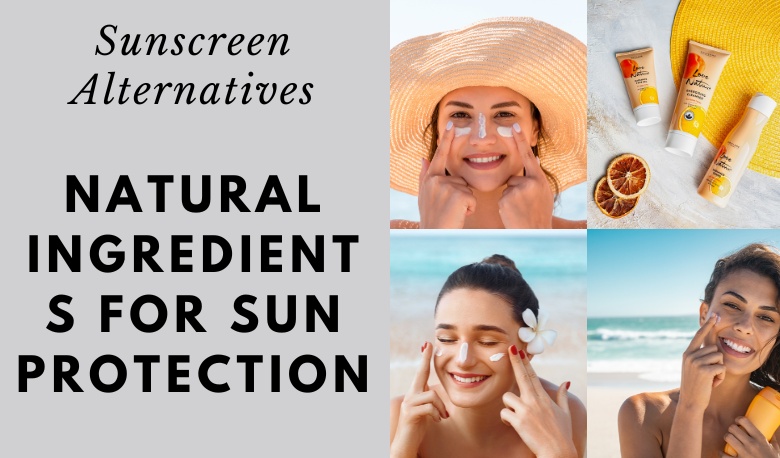We understand the importance of protecting our skin from the sun’s harmful rays, yet many are reluctant to use traditional, chemical-laden sunscreens. Whether it’s concerns about potential health risks, environmental impact, or simply wanting a more natural approach, the interest in alternative sun protection is on the rise.
Let’s explore some natural ingredients that can offer varying degrees of sun protection and support overall skin health:
Important Disclaimer: Natural solutions often lack the same level of sun protection factor (SPF) as readily available commercial sunscreens. It’s essential to be mindful of sun exposure regardless of whether you’re using these alternatives, and some may be best used in conjunction with other protective measures.
1. Protective Clothing: The First Line of Defense
- Sun-Protective Fabrics (UPF): Not all fabrics are created equal when it comes to sun protection. Look for clothing specifically designed with a UPF (Ultraviolet Protection Factor) rating. The UPF value indicates the percentage of UV radiation a fabric blocks. For example, a UPF 50 shirt means only 1/50th of the sun’s rays will penetrate the material. Choose clothing with a UPF of 30 or higher for the best protection.
- Coverage Matters: The more skin you cover, the better protected you are. Opting for long sleeves, pants, wide-brimmed hats, and sunglasses creates a substantial barrier against the sun. Consider lightweight, breathable options to stay cool and comfortable, especially in warmer weather. Natural materials like linen and cotton often provide added breathability.
2. Mineral Sunscreens
- Zinc Oxide and Titanium Dioxide: These physical blockers sit on the skin’s surface, reflecting and scattering UV rays rather than absorbing them like chemical sunscreens. They’re generally considered safer for sensitive skin and less disruptive to the environment.
3. Nourishing Oils (With Caution)
While some natural oils are believed to provide a degree of UV protection, it’s crucial to remember that they shouldn’t replace traditional sunscreens with established SPF ratings. Consider using them as a supplement to other protective measures for added skin nourishment.
- Red Raspberry Seed Oil: Red raspberry seed oil is one of the most popular natural options for sun protection, boasting a purported SPF range of 28-50. However, these numbers can vary based on the oil’s quality and how it’s applied. Importantly, red raspberry seed oil also offers antioxidants that may help mitigate some damage caused by UV exposure.
- Carrot Seed Oil: Carrot seed oil’s sun protection power is less pronounced than red raspberry seed oil. Nonetheless, it does have some UV-blocking capabilities and a rich supply of antioxidants. These antioxidants help protect skin cells and combat free radical damage caused by sun exposure.
- Coconut Oil: Coconut oil is beloved for its moisturizing properties but offers limited sun protection with an estimated SPF of 4-7. While it can provide some additional hydration, don’t rely on coconut oil alone for sun safety. It’s best used in conjunction with other, more reliable protection methods.
Important Note: The research on the true SPF values of these oils is ongoing and can sometimes be conflicting. Exercise caution and seek shade, use protective clothing, and consider a mineral-based sunscreen if you need reliable, high-level sun protection.
4. Other Potentially Helpful Ingredients
Shea Butter: This rich natural butter offers minimal sun protection (SPF 3-4) but shines in its hydrating and soothing properties. Shea butter is excellent for keeping your skin moisturized, and it can be comforting if your skin does experience some sun exposure.
Aloe Vera: Aloe vera has been a staple in natural skincare for centuries. Renowned for its skin-healing effects, aloe vera can be remarkably soothing to a sunburn, offering cooling relief and promoting faster recovery. However, it’s important to remember that aloe vera alone does not prevent sunburn or offer UV protection.
Plant-Based Antioxidants: A diet filled with colorful fruits and vegetables is naturally packed with antioxidants that can bolster your skin’s resilience from the inside out. These antioxidants help fight free radical damage caused by sun exposure. Additionally, specific supplements like astaxanthin (a potent antioxidant) have shown some promise in supporting the skin’s defenses against UV damage, although more research is needed.
Essential Notes
DIY Risks
While the allure of making your own natural sunscreen is understandable, it’s crucial to steer clear of this practice. Formulating an effective sunscreen requires precise measurements, specialized ingredients, and sterile conditions to ensure consistent SPF values and prevent contamination. Homemade concoctions are unpredictable and could give you a dangerous false sense of security.
Patch Testing
Even natural ingredients can trigger allergies or sensitivities in some people. Always perform a patch test on a small, inconspicuous area of skin before applying any new ingredient liberally. Watch for signs of redness, itching, or swelling, and discontinue use if you experience any irritation.
Limited Protection
It’s important to manage your expectations when it comes to the sun protection offered by most natural ingredients. They generally can’t compete with the high, reliable SPF values of commercially available sunscreens. If you have fair skin, a history of skin cancer, or anticipate prolonged sun exposure, prioritize proven measures like UPF clothing and mineral sunscreen. Natural options can be a helpful supplement, not a replacement.
Reapplication is Key
No matter what type of sun protection you choose, reapplication is essential. Even with some natural ingredients offering a degree of defense, their effectiveness wanes over time. Reapply your chosen protective measures every two hours, and more frequently if you’ve been sweating or swimming.
The Holistic Approach
Effective sun protection goes beyond any single product. Here’s how to integrate natural practices into a smart sun-safety routine:
- Seek Shade: Limit direct sunlight, especially during peak hours (10 AM – 4 PM).
- Morning Sun: Spending some time in the gentle morning sun helps your body produce vitamin D, essential for skin health.
- Informed Choices: If using natural options alongside commercial sunscreen, apply these first for maximum absorption.
Natural sun protection can be a valuable part of a conscious skin care approach. By understanding the limitations of natural ingredients and combining them with sensible sun habits, you can minimize UV damage and nurture healthy, radiant skin.




